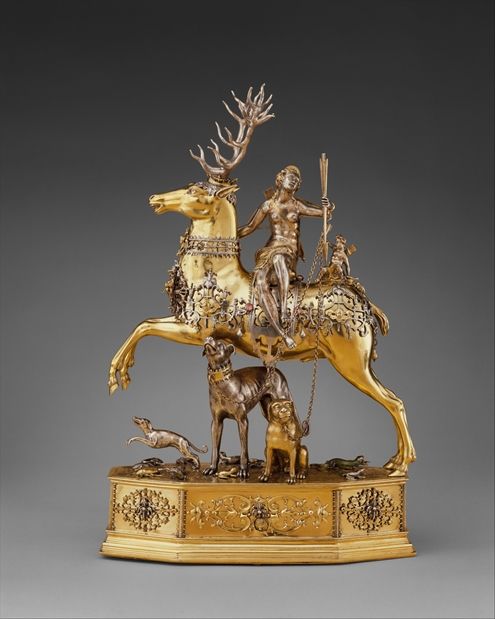
The Metropolitan Museum of Art is opening a newly redesigned gallery dedicated to Northern Renaissance Sculpture and Decorative Arts on October 3, 2023, following seven years of closure. The gallery brings together more than 100 collection highlights and spectacular recent acquisitions to situate the Museum’s extraordinary permanent collection in the context of northern Europe’s early modern society in the 16th and 17th centuries. The thematically grouped works represent the highest level of artistry and craftsmanship during the period, from ceramics, textiles, and metalwork, to clocks, chess boards, stained glass, and more. The immersive design creates shifting ambient colored light evocative of the sacred and secular interiors of the Northern Renaissance. With this reinstallation, these objects of encounter, knowledge, wonder, and personal meaning offer a window into the past for a new generation of Met visitors.
Major support for the installation of this gallery was provided by the Marina Kellen French Foundation.
"We have installed a very special gallery of awe, miracle, and artistry. During the 16th and 17th centuries, a remarkable outpouring of creativity and ideas gave rise to objects that were both magnificent artistic accomplishments and technological wonders," said Max Hollein, The Met’s Marina Kellen French Director and CEO. "Through thoughtful new displays, the stunning reinstallation of the Northern Renaissance Sculpture and Decorative Arts gallery reveals the desire to construct, claim, explain, and represent the world in singular objects and tells the fascinating and complex backstories of these works."
Sarah Lawrence, Iris and B. Gerald Cantor Curator in Charge of the Department of European Sculpture and Decorative Arts, said, "The long-awaited reopening of the gallery will surprise and delight our visitors by the beauty of the objects on view and the compelling stories they tell."
Wolfram Koeppe, Marina Kellen French Senior Curator in the Department of European Sculpture and Decorative Arts, added, "Works of art shaped the Renaissance, a rediscovery of antiquity that began in the 15th century in Italy. Traders and traveling artisans spread prints illustrating Greek and Roman art, architecture, and manuscripts across the Alpine mountains. Valued for their refinement, many of the works of art in this gallery were specially placed in Kunst-und-Wunderkammern, the art and science collections that were the first step towards today’s museums."
The gallery (Gallery 520) includes works from roughly 1520 to 1630, when Europeans north of the Alpine mountains experienced civil unrest, religious revolution, and an increasingly globalized world. Dealings with European colonial powers, who were exploiting the people and land overseas, added to the regions’ fast-growing wealth as banking systems advanced and merchant networks aggressively extended their markets. The dominance of the Catholic Church was destabilized as the Reformation led to the rise of various Protestant denominations. Politically, the Holy Roman Empire (962–1806) dominated northern lands and linked hundreds of independent territories and Imperial city-states. Due to conflicts between religious groups, peasant wars against oppressive aristocracy, and brutal clashes with neighboring nations, social and political boundaries remained in flux. Within this complex society, art expressed ownership and belief. Royals, who competed fiercely to commission artists, understood that it instilled awe and projected power.
The redesigned space explores the religious, imperial, and colonial contexts in which these objects were made. It is divided between two overarching themes: "Belief," anchored with a display of stained glass on the south end of the gallery, and "Knowledge," anchored with a deconstructed Kunstkammer on the north end of the gallery. The works are grouped into eight sub-themes, such as "Encounter," "Making," "Study," and "Ritual" and videos featuring select objects play on two screens in the gallery. The array of objects on view includes a bronze sculpture of Apollo by Adriaen de Vries from about 1594–98, a masterful northern interpretation after the ancient marble Apollo Belvedere in The Vatican Museums. The Orpheus Cup, an exceedingly rare gold cup and cover acquired by The Met in 2019, features a complex iconographic program of painted enamel ovals illustrating scenes from Ovid’s Metamorphoses. Recent research established that the cup, made at the Viennese 17th-century court of Emperor Ferdinand III, was part of the legendary 18th-century art collection of Duke Charles Alexandre of Lorraine in Brussels, brother-in-law of Habsburg Empress Maria-Theresa and uncle to Queen Marie-Antoinette of France. Another recent addition is an iconic silver ewer by Adam van Vianen, signed and dated 1619. The Dutch goldsmith is celebrated for his creations in the so-called Auricular Style, featuring organic and fluid forms reminiscent of the inner ear and resembling the thickening flow of molten lava.
The gallery closed in the fall of 2016 when construction work began on the adjacent British Galleries and the space was used for temporary art storage. The reopening allows for visitor flow to resume between the Northern Renaissance collection, the Lehman Wing, and the Medieval Hall, creating a seamless transition between various departments with decorative arts displays.
This project is led by Wolfram Koeppe, Marina Kellen French Senior Curator in the Department of European Sculpture and Decorative Arts, which is overseen by Sarah Lawrence, Iris and B. Gerald Cantor Curator in Charge.
Layered Narratives: The Northern Renaissance Gallery is featured on The Met’s website, as well as on the Museum’s social media channels and the @met_esda Instagram account using the hashtag #MetESDA.
###
September 27, 2023
Contact: Jennifer Isakowitz:
Communications@metmuseum.org
Image: Joachim Friess (ca. 1579–1620, master 1610). Diana and the Stag, ca. 1620. German, Augsburg. Partially gilded silver,
enamel, jewels (case); iron, wood (movement). 14 3/4 × 9 1/2 in., 5 lb. (37.5 × 24.1 cm, 2250g). The Metropolitan Museum of Art, Gift of J. Pierpont Morgan, 1917 (17.190.746)
Press resources